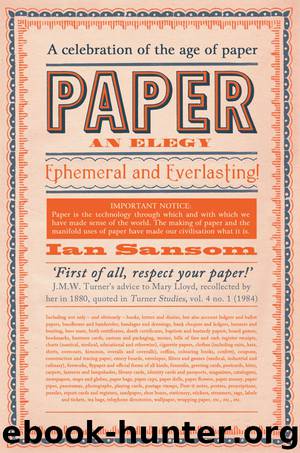Paper by Ian Sansom

Author:Ian Sansom
Language: eng
Format: epub
ISBN: 9780062295613
Publisher: HarperCollins
Published: 2013-04-26T16:00:00+00:00
9
THE SQUIGGLE GAME
This game that I like playing has no rules. I just take my pencil and go like that . . .
D.W.WINNICOTT, “The Squiggle Game” (1968)
Handmade paper incorporating flower petals
The story goes that Bodhidharma, the big-bearded, mad-eyed monk who brought Zen Buddhism from India to China, and who taught martial arts to the Shaolin monks, once spent nine years meditating, facing a wall. Nine years. He spent so long meditating, in fact, that his image became engraved on the wall and his legs fell off: tales of Bodhidharma make Butler’s Lives of the Saints seem like a walk in the park. In another story, Bodhidharma is said to have nodded off while meditating: on waking, he promptly cut off his eyelids in self-disgust. According to the story, when his eyelids hit the ground, tea plants sprang miraculously from it, which is why tea is used as a stimulant to keep students of meditation awake. In yet another story, Bodhidharma is said to have refused to teach a student until the student had cut off his arm in order to demonstrate his sincerity, a teaching method that, like many teachers, I am sorely tempted to employ. And in yet another tale, the Emperor Wu is said to have asked Bodhidharma what was the meaning of truth, to which he winningly replied that there was no truth, only the eternal void. But to return to the nine-years-meditating-and-legs-withering-away story: this explains why the Japanese papier-mâché dolls known as Dharma or Daruma dolls, which are representations of Bodhidharma, have no legs. They are round and hollow, and weighted at the bottom—like Weebles they wobble, but they don’t fall down, wherein lies their moral—and each spring, fairs are held in Japan at which the dolls are sold and blessed, to act as good-luck charms for the coming year. The previous year’s dolls are ceremonially burned. So it goes: the great Buddhist holy man becomes first a legend, and then a papier-mâché doll destined for the flames.
Toys are not only an expression of culture, they are a fundamental means of acculturation, the means by which and through which we teach ourselves about ourselves. The cultural theorist Walter Benjamin—who collected not only toys and word games, and puzzles and brainteasers, and nice stationery, but also the odd and amusing remarks of his young son, Stefan—asks in one of his several essays on toys, “For who gives the child his toys if not adults? And even if he retains a certain power to accept or reject them, a not insignificant proportion of the oldest toys . . . are in a certain sense imposed on him as cult implements that became toys only afterward, partly through the child’s powers of imagination” (“Toys and Play,” 1928). Paper has played a central role in this two-way system of imposition and emancipation: infinitely scriptable and flexible, paper is the cult implement to beat all cult implements. Paper playthings, and playthings made of paper, abound and surround us from childhood to
Download
This site does not store any files on its server. We only index and link to content provided by other sites. Please contact the content providers to delete copyright contents if any and email us, we'll remove relevant links or contents immediately.
Cecilia; Or, Memoirs of an Heiress — Volume 1 by Fanny Burney(32434)
Cecilia; Or, Memoirs of an Heiress — Volume 2 by Fanny Burney(31871)
Cecilia; Or, Memoirs of an Heiress — Volume 3 by Fanny Burney(31854)
The Lost Art of Listening by Michael P. Nichols(7406)
Asking the Right Questions: A Guide to Critical Thinking by M. Neil Browne & Stuart M. Keeley(5635)
We Need to Talk by Celeste Headlee(5542)
On Writing A Memoir of the Craft by Stephen King(4863)
Dialogue by Robert McKee(4321)
Pre-Suasion: A Revolutionary Way to Influence and Persuade by Robert Cialdini(4150)
I Have Something to Say: Mastering the Art of Public Speaking in an Age of Disconnection by John Bowe(3840)
Elements of Style 2017 by Richard De A'Morelli(3307)
The Book of Human Emotions by Tiffany Watt Smith(3238)
Fluent Forever: How to Learn Any Language Fast and Never Forget It by Gabriel Wyner(3028)
Name Book, The: Over 10,000 Names--Their Meanings, Origins, and Spiritual Significance by Astoria Dorothy(2939)
Good Humor, Bad Taste: A Sociology of the Joke by Kuipers Giselinde(2903)
Why I Write by George Orwell(2874)
The Art Of Deception by Kevin Mitnick(2736)
The Grammaring Guide to English Grammar with Exercises by Péter Simon(2710)
Ancient Worlds by Michael Scott(2625)
